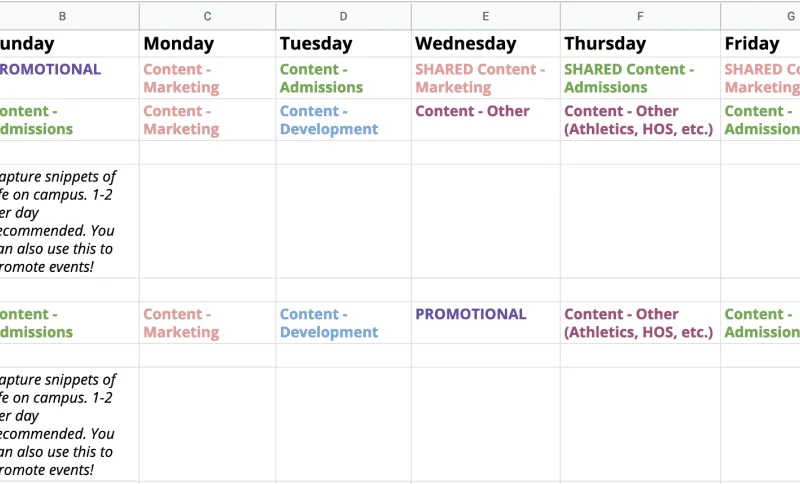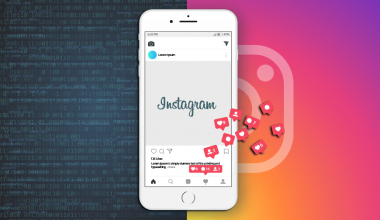As a Type-A personality, that is a favorite expression of mine. And, having spent many years managing numerous social media platforms in marketing and media, I’ve discovered the hard way that this is one area where you just cannot wing it. Especially if you manage numerous channels.
You need a social media content calendar.
A social media calendar is crucial for developing a social media presence, whether you are a personal brand builder, creator, or social media manager.
But you’re reading this essay, so I’m preaching to the choir, so let’s get right into it. I’ll go over the benefits of using a social media calendar as well as how to create your own using Buffer. Along with a ready-to-use social media calendar template, I’ll also provide the social media calendar system that our marketing team uses.
A social media calendar is a complete list of your upcoming postings, sorted by date and time. It may take the form of a document, a spreadsheet, or an interactive dashboard.
Social marketers utilize content calendars to plan posts, manage campaigns, and evaluate current strategies.
Every entry in a social media calendar usually contains some combination of these elements:
- The post creatives (copy, images, videos, links, tags, etc.)
- The date and hour that it will be live
- The social network and account from which it will be published
A content calendar is essential for a successful social media plan since it provides numerous benefits, including time savings and improved collaboration.
Here are a few.
#1. It saves time and increases team bandwidth
A social media calendar helps you keep organized while maintaining many accounts, which saves you time. As a social media manager, planning a social calendar month saves you from having to scour current topics and news headlines every day for ideas. It will also offer you more time to track and try various techniques to see which ones are most effective with your target audience. Your team will also have more time to work on high-quality content.
#2. Keep a consistent posting schedule
Of course, there is no hard rule regarding how much you should post, but posting frequently is necessary to maintain an active presence. A social media content calendar enables teams to emphasize quality over quantity. Furthermore, planning will result in greater consistency in terms of your brand voice and style, as opposed to posting in a reactive or unplanned manner.
#3. Quality assurance and brand safety
Proactive scheduling enables social teams to review their work and maintain their brand’s reputation. When you’re not hurrying and have a workflow approval process in place, it’s easy to spot a typo or avoid a major public relations disaster. Using a social media calendar will help you identify these errors sooner rather than later.
#4. Streamline cross-functional collaboration
A well-crafted social media calendar increases visibility by providing a comprehensive summary of all future content. A content calendar improves communication and cross-functional collaboration by allowing everyone to see what’s coming up. It also encourages alignment for departmental or organizational-wide goals by providing a consistent publishing schedule.
Having a posting plan is essential since your social media should help your overall organizational marketing strategy. For example, your team can verify that social posts align with broader efforts. Stakeholders in the campaign may readily see what you’ve planned and provide comments as needed.
- Key
- URL and UTM Parameters
- Date and Time
- Message
- Campaign
- Image
Perfecting your social media content calendar shouldn’t be a chore. Below, I’ll walk you through the main components of any social media content calendar, which will serve as the foundation for organizing your social media strategy on a tactical level.
#1. Key
An easy-to-read key can help your stakeholders grasp the information on your calendar.
As long as your key is obvious, almost anyone in your business can read your social media content calendar and understand what’s going on across all channels.
#2. URL and UTM Parameters
URLs and UTM parameters are similar but not identical. URLs are the links you want to publish from your website (or another website if you’re curating content) on social media.
A UTM parameter is an extension to your URL. It’s a string of tracking codes added at the end of a URL that allows social media marketers to monitor how well their postings drive visitors to their websites. By tracking and analyzing UTM parameters, you may determine which content fulfills your conversion objectives and which material generates the greatest engagement on social media sites. To make this procedure easier, consider using a UTM generator.
#3. Date and Time
Incorporating dates and times into your social media calendar is beneficial not only for planning purposes but also for stakeholders and other teams that rely on your content.
When teammates can check your calendar and see exactly when a post was or will be scheduled, they can move more swiftly through their workflow, which benefits you as well. AKA, you will not be interrupted to provide status updates on every tweet scheduled for the day.
#4. Message
Transparency and context are crucial in social media content calendars. Giving a brief overview of the content or even sharing the caption for a post can go a long way toward helping individuals on and off your team understand what the post’s objective is.
Pro tip: If you’re adding an unfinished video to your social media content calendar, include a short Loom video that provides an outline of what the video will be about. You only need to create the Loom once, so you won’t have to re-record your explanation each time someone asks a question.
#5. Campaign
It is too late to start measuring metrics after your campaign has ended. Instead, begin tracking your social media initiatives within your content calendar. You can make this more prescriptive by including a drop-down choice of predetermined campaign names, or if your campaigns are few and far between, simply copy and paste the names next to the relevant information.
Pro tip: For smooth tracking, align your campaign name with the campaign portion of your UTM parameters.
#6. Image
Without images, your social media content calendar will be nothing more than a spreadsheet. Because much of your social media content will be visual, including a thumbnail-sized version of the image you’ll use in the published post. With the message, stakeholders who view the calendar photos will have a solid understanding of what will be communicated and when.
To create an appealing social media calendar, be sure to provide a variety of material and minimize overlap or repetition.
But how do you go about establishing a calendar that perfectly fits your team’s workflow? We explained the simple, step-by-step procedure for you:
#1. Select your post type and format
Not sure what to put on your social media content calendar? The golden guideline is to use a variety of material types (pictures, videos, gifs, articles, reposts) and forms.
Begin by filling up your calendar with recurring activities. Here are some content ideas for post types that can be planned ahead of time:
- Holidays: A social media event calendar is an excellent way to ensure that you don’t forget anything significant. Choose all of the holidays that are relevant to your portion of the world and brainstorm content ideas.
- Events: Anything that you believe is significant to your brand at the national, local, and internal levels.
- Product or feature debuts: If your team is working on a new feature or product, it’s always a good idea to generate excitement on social media through teasers and big reveals.
- Sales: Add Black Friday, Cyber Monday, Giving Tuesday, and other events to your calendar to stay on top of them.
- Company news: Maintaining communication with your audience is usually a smart idea.
- Q&As: Very simple to set up and schedule, and an excellent method to engage your audience.
- Roundups: These work particularly nicely with Twitter threads. Many individuals will not have the time to read all of your stuff, so a small, weekly newsletter initiative would be very welcome.
#2. Establish your posting frequency.
Now that you know what to post, you must decide when to post it.
A social media posting schedule is useful for two reasons. First and foremost, social media should be used to augment, not replace, your existing marketing activities. Second, because social media moves so quickly, it is easy to become overwhelmed and publish excessively or insufficiently. Both of these can cause a reduction in engagement.
Your business goals, the resources you have, and audience engagement trends should all influence your publishing schedule.
Social media professionals suggest the following posting frequency:
- Instagram postings: 3-5 posts per week.
- Instagram reel: 5-7 reels every week.
- Instagram stories: 7-15 stories each week.
- Facebook posts: 3-5 posts every week.
- Twitter posts: 10–20 tweets each week.
- Linkedin posts: 3-5 each week.
- TikTok posts: 5-7 per week.
- Google My Business posts: 1-3 each week.
#3. Choose the appropriate platforms for you.
Are you planning to publish to a single social network or multiple? Consider your business objectives and available resources. What are you hoping to accomplish, and how much time and money are you ready to invest?
Begin by looking closely at your competitors: where do they post the most, and which platforms do they completely ignore? Then conduct a thorough investigation into your target audience: where do they hang out, and what does their behavior tell you?
Don’t feel obligated to be on every social media platform; you’ll wind up spreading yourself out with nothing to show for your efforts. If you’re not sure which social media platform to utilize, begin with the three most popular (Instagram, Facebook, and LinkedIn) and then expand from there.
#4. Collaborate, provide input, and approve posts
When it comes time to share your social media content calendar with the marketing team, you should have a clear protocol in place so that everyone understands what is expected of them.
A platform like Planable can help your social media team better manage content planning by allowing you to know what’s being worked on, who is working on it, and when it will go live. This ensures that you avoid not only shocks or last-minute scrambling to complete tasks but also content overlaps or gaps.
Social media campaigns have several moving pieces, including approval. Who gets to approve what? What types of materials are essential enough to require multiple layers of approval? Should clients have a say on a particular piece of content?
If you’ve faced these three difficulties, that’s three more than you should have. Planable’s approval procedure is straightforward and intuitive, which helps to avoid major mistakes. You know what I mean: writing the same thing again, unintentionally publishing an incomplete post, or an unhappy employee posting on the company’s behalf.
#5. Schedule, schedule, and monitor your postings
By planning and scheduling your posts ahead of time, you may incorporate failsafes into your process. Scheduling allows your team and partners enough time to revise and fact-check the content. Planning with a social media calendar also allows you to add an extra layer of security by having organizational stakeholders approve the material to ensure it follows brand requirements, such as tone of voice and design components.
Once your posts are live, track their performance to determine which ones generate the most interaction and drive outcomes. Use your data to do tests on various platforms and see what resonates with your audience, such as content types, publishing days and hours, copy length, hashtags, and multimedia assets.
Check out these four social media calendar tools.
When you’re ready to complete your calendar, you’ll need a dependable tool. Below are four of our favorite beginner-friendly options:
#1. Google Sheets
Google Sheets is a free alternative to Microsoft Excel. It also makes it easier for small businesses to create their social media content calendar.
Sheets sync across various devices and support sharing, allowing team members to effortlessly collaborate on content.
Our free template allows you to create a bespoke social media calendar.
Google Sheets will assist you in planning ahead of time to guarantee that each platform has a well-balanced content distribution. But it will not post for you.
To share information on social media, copy and paste your posts into a social media scheduling tool (such as Social Poster).
Semrush Social is a set of tools that help you plan, create, and publish content.
We’ve already discussed several specific use cases for the tools listed above. However, here is a basic summary of what you may do with them:
- Create and save post-drafts.
- Schedule and automatically post content on specified dates and times.
- Get content ideas from your favorite blogs and websites.
- Follow your competitors’ social media accounts.
- See how your accounts compare to competitors’ accounts.
- Find top-performing content to understand the topics your audience cares about.
- Evaluate the content’s performance.
- Understand your audience’s demographics.
- Discover when your audience is most active.
- Learn what material your fans enjoy and dislike.
#3. Canva
Canva is a free, beginner-friendly online design tool that allows you to create professional-quality visuals for your social media networks.
The Pro plan (starting at $12.99 per month) allows you to create, plan, and schedule social media posts using a simple calendar interface.
Canva allows you to schedule articles for the best times and provides a zoomed-out view of the upcoming weeks.
The calendar also includes famous social media dates from around the world, allowing you to plan posts for potentially viral occasions.
Each post contains basic insights for tracking impressions, reach, likes, and comments:
If you predominantly use visual material, a Canvas content planner is an easy way to make the most of your social content calendar.
#4. Trello
Trello is a project management solution that allows for team collaboration. Trello boards allow you to create lists for each platform by dragging and dropping “cards.”.
Alternatively, you can create separate boards (up to ten on the free plan) for each social network.
Here’s how Girl Knows Tech utilizes Trello to create an Instagram content calendar:
Use cards to upload social content and establish deadlines for each stage (e.g., content development, scheduling, and posting). To identify specific information types, use color-coded labels.
Trello helps you organize and streamline your workflow. However, like Google Sheets, it cannot automate sharing or track performance. This solution excels as a planner when combined with scheduling and analytics tools.
There are lots of social media planners available, and the ideal one will depend on your requirements and tastes.
Not sure whether to use a content calendar or not? Consider this: everyone uses one, including your competitors.
Everyone who is directly or indirectly involved in the creation process should consider adopting a social media calendar.
- Content creators: Content generation and social media go hand in hand. Creating a calendar around your blog posts is an excellent approach to integrating your content into the social media ecosystem, whether you are an influencer or a digital producer.
- Marketing teams: Of course, I am referring to social media managers. Marketing campaigns are sophisticated machinery with many moving elements. Social media is only one of many cogs in the machine, and planning content ahead of time allows teams to focus on what happens behind the scenes.
- Social media management companies: It’s not unreasonable to presume that agencies serve several clients. Organizing all clients by calendar is an excellent approach to staying on top of their individual needs.
- Small and Big Businesses: Businesses may not have the means to employ an agency to manage their social profiles; therefore, a content calendar facilitates in-house social media marketing.
Wrap Up
If you want to step up your social media game, a calendar is the way to go. It will help you post more consistently and save time. So roll up your sleeves and get creative!
- TEAM CALENDAR: What It Is, Best Team Calendar & Free Apps
- Shared Calendar App: Best Calendar Sharing Apps 2023
- FAMILY CALENDAR APP: Top Rated Free Apps for iPhones & Android
- FAMILY CALENDAR: What Is It, Importance, Best Apps & Calendar






